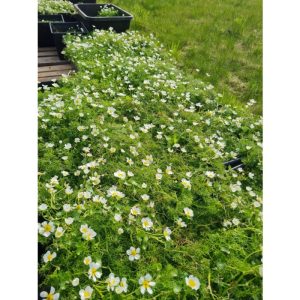Home " Oxygen plants " Large water vine
TL;DR The Large Water Ranunculus (Ranunculus peltatus) is a native oxygen plant with remarkably large flowers measuring 3 to 5 cm. The species has both finely divided underwater leaves and hand-shaped floating leaves and is suitable for clear, fresh water in garden ponds and natural areas. Order easily through our partner: Order large water vine at Pond Master.
The Large water vine is a spectacular aquatic plant that lives up to its name with flowers up to 5 cm in diameter - the largest within the group of water vine in the Netherlands. The white flowers with a striking yellow base bloom from May to August and are a recognisable sight in natural waters.
The plant belongs to the Ranunculus family and is counted among the hydrophytes: plants that live in or under water. The scientific name Ranunculus peltatus refers to the floating leaves that are shield-shaped (pelta means shield).
Order easily via our partner: Order large water vine at Pond Master.
The plant has two leaf types: submerged leaves divided into fine slips, and floating leaves that are hand-shaped with five lobed segments. This combination makes the species particularly suited to clear, nutrient-poor to moderately nutrient-rich waters.
The stems can grow up to 3 metres long. Flowering takes place at the water surface and sometimes above it, and the petals barely overlap. The flower base is hairy and the fruit stalks can be more than 5 cm long. After flowering, achenes of about 1.5-2 mm, often weakly hairy, form.
The Large Water Ranunculus prefers to grow in still or slow-flowing, clear water with a soil of sand, peat or light clay. It is capable of growing even under ice and emerges early in spring. As a result, it forms a stable and long-term source of oxygen.
In temporarily dry spots, the plant adapts by developing stiffer leaves with shorter slips and smaller flowers. This makes it flexible in both garden ponds and natural areas.
The species is native to large parts of Europe and North Africa. In the Netherlands, it is particularly found in the higher sandy areas and peatlands where the water is iron-rich and slightly nutrient-rich. Its low phosphate and carbonate content contribute to optimal development.
Ecologically, the Large Water Ranunculus is of great importance. The flowers attract pollinators and the underwater parts provide shelter for larvae, young fish and macrofauna. Thus, the plant actively contributes to biodiversity and the self-purification of water.
Large water vine can be planted in both natural ponds and garden ponds. Preferably choose a planting zone 20 to 60 cm deep with sufficient light penetration. The plant grows best in pond soil or a substrate layer at the bottom.
No additional maintenance is usually required during the growing season. Any proliferation can easily be cut back in summer. In winter, the above-ground parts partly die off, but the plant sprouts again early in spring.
The plant is often confused with the Middle (formerly Fine) water vine. However, it has smaller flowers (usually <3 cm) and shorter fruiting stems. When determining, note the size of the petals and the shape of the leaves.
There are two varieties of the Great water vine: one for standing water and one for flowing water. These are difficult to tell apart, but both are ecologically valuable and visually appealing.

Large water vine can be ordered through our sales partner Vijvermeester.nl.
Zuurstofplanten.net is a website of Dutch Water Tech. Specialist in water treatment for municipalities and water boards. Would you like to know more? Visit dutchwatertech.co.uk for more information on our projects.
Dutch Water Tech BV
Gateway 1
4613 BW Bergen op Zoom
You can buy oxygen plants, bank plants and other pond products through our partner Vijvermeester.nl.
© 2025 Dutch Water Tech. All rights reserved.